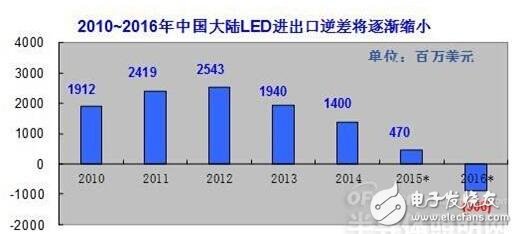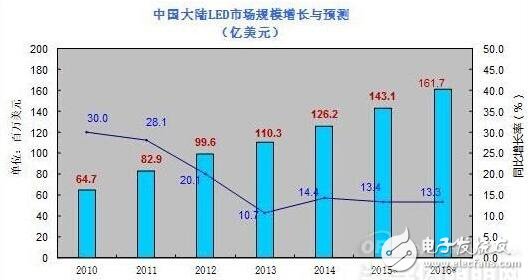Mainland China is the world's leading LED exporter. According to customs statistics, in 2014, a total of 201.8 billion LEDs were exported, with an export value of 4.77 billion US dollars (accounting for 42.5% of local LED production and sales), which increased by 222.4% and 37.5% respectively. It is estimated that LED exports in 2015 and 2016 will increase by 35% and 32% respectively, and exports will reach 64 and 8.5 billion US dollars.
China's LED import and export rapid growth
According to customs statistics, in 2014, the import volume of LED products in mainland China was 141 billion, an increase of 85.5% year-on-year; the import value was US$6.17 billion, a year-on-year increase of 14.0%. Imports are expected to continue to grow by around 10% in 2015-2016, reaching $69 and $7.6 billion, respectively.
China's LED import and export volume deficit has gradually narrowed
From the development trend of LED import and export trade, the trade deficit in 2015 will be reduced to 470 million US dollars, and the trade surplus will reach about 900 million US dollars by 2016 (see the following figure).

China's LED market growth and forecast
In 2014, the LED market in mainland China increased by 14.4% year-on-year to reach US$12.62 billion. The import value was 6.17 billion US dollars, accounting for 48.9% of the market demand. It is expected that the market size will grow by more than 13% next year, exceeding $140 and $16 billion respectively (see chart below).

2015 China LED market development trend
(1) The growth rate of the LED packaging market has slowed down.
From the perspective of various application fields, the growth of the LED packaging market is the main driving force; in the small-sized backlight field, although the penetration of smartphones has increased and the size has increased, the market demand has increased, but it is not enough for the entire packaging market. It has too much impact.
(2) Acquisition and merger become the norm.
Although the overall demand of the LED industry is large, the competition is too fierce due to the low threshold, and the profitability of many companies in the industry is relatively weak, and some are on the verge of bankruptcy. In 2014, 76% of the 17 key LED listed companies involved mergers and acquisitions, and this trend will continue in 2015.
(3) Intelligent lighting has shifted from concept to industrialization.
At present, intelligent lighting has been applied to production and life, such as dimming color management, mobile phones, APP remote control, etc. Currently, about 20% of designers use intelligent lighting products in their projects, and the future intelligent lighting system will be more Popularization, towards industrialization and intensification.
(4) More and more LED manufacturers are beginning to enter the field of invisible light.
Due to the fierce competition in LED prices, manufacturers are actively looking for new special applications that can increase profitability; for example, invisible LEDs (including UV or IRLED) that are receiving increasing attention. Although the market size of invisible LEDs is limited, its entry threshold is high, and the gross profit margin of products is significantly better than that of white LEDs. It is expected that more and more LED manufacturers will enter the field of invisible LEDs in the future.
(5) The automotive LED market will grow steadily.
Among them, LED lighting such as daytime running lights (DRL) and headlights (H/Lbeam) grows faster. The main reason is the technical improvement of LED and the decline in price, which makes the LED lighting of vehicles gradually shift from high-end models to mid-end models. In addition, with the increasing popularity of multimedia and sensing images, traditional instrument panels have also been changed to LCD panels, driving the need for automotive backlights.
(6) The backlight pursues thinness and high color saturation.
Taking handheld devices as an example, high-end mobile phones are gradually becoming thinner and lighter and higher in panel resolution. For LED manufacturers, how to make LEDs thinner and brighter is the target of 2015. As for TV LED backlight specifications, in addition to improving LED brightness to meet the needs of 4K2K panels, the introduction of special red phosphors to achieve high color saturation LEDs of NTSC100 is also the focus of LED manufacturers.
China LED patent situation
In 1968, the Changchun Institute of Physics of the Chinese Academy of Sciences successfully developed the first LED in mainland China. In the 1980s, China's LED materials and devices have formed an industry. In the 1990s, it began to develop rapidly. The company mainly concentrated on the packaging downstream of the LED industry chain. And application aspects.
In terms of quantity alone, China has the largest number of LED patents in the world's top five. Among them, the number of patents in mainland China is located behind the United States and Japan, roughly equivalent to Germany and Taiwan, but there are a considerable number of utility model patents. .
However, in mainland China, in the field of epitaxial technology and chip structure in the upstream and middle of the LED industry chain, the number of patent applications is much lower than that of Japan and the United States, and lower than that of Germany and Taiwan; the number of patent applications for substrate technology in mainland China It is roughly equivalent to the United States. The number of patent applications for phosphor materials is second only to Japan. The number of patent applications for packaging technology is roughly equivalent to that of Taiwan, and the number of patent applications for LED applications has exceeded that of the United States and Japan.
Moreover, before 2006, the main components of LED invention patent applicants in mainland China were the undertakers and implementation units of the National 863 Program, such as the Institute of Semiconductors, Institute of Physics, Changchun Institute of Optics, Nanjing University, Peking University, Tsinghua University, Zhejiang University and Nanchang University. At that time, China's overall emphasis on LED basic research and development was not strong enough, but the key factor may be that the patent awareness of enterprises and even research institutions is not strong enough. After 2006, the number of patent applications corresponding to LED companies as LED invention patents has increased rapidly, indicating that Chinese LED companies have greatly strengthened their technological strength and patent protection awareness with the development of the market. Patents can bring wealth and avoid risks.
Development opportunities and challenges facing the LED industry
Development opportunities facing:
(1) Intelligent lighting or become the next “gold mine†for LED power companies. In 2014, smart lighting was booming, and various smart drive and dimming technologies were also followed. In the two years from 2014 to 2015 alone, the intelligent lighting industry will provide an additional market space of at least RMB 60 billion. By 2018 this value will reach nearly 80 billion yuan. The establishment of intelligent lighting trends will open up a broader space for growth in the LED industry.
(2) Emerging markets are welcoming new business opportunities for Chinese exporters. In the Russian market, LED lighting showed a significant growth in 2014, reaching 2.48 billion US dollars, and the penetration rate reached 32%. By 2016, the LED lighting market is estimated to reach US$5.07 billion, and the penetration rate will reach 44%. In Southeast Asia, in the six major countries of Thailand, Singapore, Malaysia, Vietnam, Indonesia and the Philippines, the LED lighting scale in 2014 was about 1.1 billion US dollars, and the LED penetration rate reached 25%. It is expected that in the next few years, Southeast Asia is gradually becoming a new nugget for Chinese LED lighting manufacturers.
(3) The automotive lamp market will become another big blue ocean after LED followed by commercial lighting.
It is predicted that from 2013 to 2019, the market share of LED headlights will increase from 1% to 10%. The automotive lighting field is gradually optimistic, and the entire automotive lamp market will become another big blue ocean after LED commercial lighting.
Challenge
(1) Industry shuffling speed will increase.
Looking forward to 2015, the packaging industry is still fiercely competitive, especially in the field of lighting packaging, and it is still difficult to improve the profitability of enterprises. In the case of major expansion of packaging companies, the industry's shuffling speed will increase.
(2) More and more lighting companies have encountered patent technology thresholds.
As the sales volume of China's lighting fixtures continues to increase, more and more lighting companies encounter the threshold of patent technology, and the issue of patent restrictions will promote lighting companies to increase technological innovation.
KNB1-63 Miniature Circuit Breaker
KNB1-63 Mini Circuit breakers, also named as the air switch which have a short for arc extinguishing device. It is a switch role, and also is a automatic protection of low-voltage electrical distribution. Its role is equivalent to the combination of switch. Fuse. Thermal Relay and other electrical components. It mainly used for short circuit and overload protection. Generally, According to the poles, mini Circuit breaker can be divided into 1P , 1P+N , 2P, 3P and 4P.
KNB1-63 Miniature Circuit Breaker,Electronics Miniature Circuits Breaker,Automatic Miniature Circuit Breaker,Mini Circuit Breaker
Wenzhou Korlen Electric Appliances Co., Ltd. , https://www.korlen-electric.com
